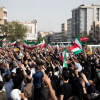How can the land of Hafez, Sa’di, and Rumi be so cruel?

"Listen with ears of tolerance. See through the eyes of compassion. Speak with the language of love."
– Jalal ad-Din Muhammad Rumi, 13th-century Iranian philosopher-poet
Nayereh Jalali, a grieving mother, kept looking for the graves of her children. She carried a photograph of six young smiling faces, including one of a woman with shiny black hair. Also known as Mother Behkish, Jalali would frequently visit the Khavaran Cemetery in southeastern Tehran until she died on January 3 this year in her Tehran home. She was one of the "Khavaran Mothers" – those whose children were killed in shootouts or executed en masse in the 1980s, often with a summary or no trial. These mothers search for any sign of their loved ones – an unmarked grave, a bone, anything. The authorities used the Khavaran Cemetery to dispose of the bodies of perceived communists, leftists, political dissidents, and the Baha'is.
Mother Lofti was another such woman. Once, while visiting the cemetery with flowers, she heard her sister scream, "What is that hand doing there?" It was sticking out from a shallow grave. All the mothers in the cemetery started to wail and scream in unfathomable grief. The term "Khavaran Mothers" has since become a generic name for all such mothers. Cemeteries like this sprang up in many cities. They are collectively known as "Khavarans."
Men and women who the authorities suspected had any affiliation with the political parties not aligned with the ruling clerics were hung from cranes, four at a time, for a few minutes, and were then hurriedly dumped in mass graves, often still alive. Sometimes, groups of six were hanged on the stage in an assembly hall or shot by the firing squad. By mid-August in 1988, thousands were murdered in such gruesome manners – without trial, without appeal, and utterly without mercy. Sometimes, women were whipped five times a day until they died from the wounds. (Geoffrey Robertson, Mullahs without Mercy, Random House Australia, 2012.)
Sadly, these tortures and killings continue to this day.
Mahsa Amini, a 22-year-old Kurdish woman, was just one of many to meet such brutal and violent deaths. About to start university, she had gone to Tehran to visit her relatives. On September 13, as she was getting out of the Haghani underground station, the notorious Morality Police arrested her because she was not wearing her headscarf properly, a mandatory requirement for women in Iran. After three days, she died in police custody from a "violent blow to the head," according to her family living in Iraq. Her a CT scan of her skull showed bone fracture, haemorrhage, and brain oedema, supporting the family's narrative. The state coroner, however, denied the claim, saying the death was the result of a cardiac arrest.

How could the ruling clerics be so repressive and brutal in Iran, a beautiful country with millennia of rich heritage and a deep-rooted Sufi tradition? It is the land of Jalal ad-Din Muhammad Rumi (1207-1273), Sheikh Sa'di (1210-1291), and Hafez Shiraz (1315-1390), the philosophers who taught the power of love, compassion, and empathy to the entire world. Persian culture is owed to the benevolent Sufi philosophy of these poets and other philosophers that also influenced the world in myriad ways. These poet-philosophers knew how to express the fundamentals of the human condition and the power of love, and to encourage faith in a higher purpose and meaning in life. Have the merciless, brutal, absolutist Iranian rulers lost touch with their roots?
Nevertheless, the street protests are going on unabated across Iran. It's not an anti-hijab protest – it is an expression of the Iranian people's legitimate anger towards their loss of freedom. It's not only women, but many men are also supporting and taking part in the protests. As public anger rages on, Tehran has reportedly disbanded the Morality Police, though the government has denied any such report. Some say it is too good to be true. Recently, authorities demolished the home of rock climber Elnaz Rekabi because she competed abroad without the mandatory hijab.
But Iranians must not lose hope. Sa'di wrote in his most famous work, Golestan: "Created from one essence, people are members of a single body. Should one member suffer pain, the rest shall, too. You who feel no sorrow for the distress of others cannot be called a human being."
During his time, Iran was going through the most turbulent period of history. The Mongol army, led by Genghis Khan and his grandson Hülegü Khan, tore through Iran three times between 1220 and 1256, laying waste to cities and slaughtering all the inhabitants. Rumi fled the Mongols and travelled from Balkh westwards to save his life. Attar of Nishapur (1145-1220), a mystic poet, was murdered by the Mongols. Sa'di could well be another such victim of violence, had he not left his hometown Shiraz as the Mongols began their massacre in eastern Iran. But still, Sa'di never lost faith and hope in humankind. Today's Iran shouldn't either.
We do hope that good sense will prevail in Iran, and this great country will find its own way forward.
Dr Sayeed Ahmed is a consulting engineer and the CEO of Bayside Analytix, a technology-focused strategy and management consulting organisation.

 For all latest news, follow The Daily Star's Google News channel.
For all latest news, follow The Daily Star's Google News channel. 










Comments